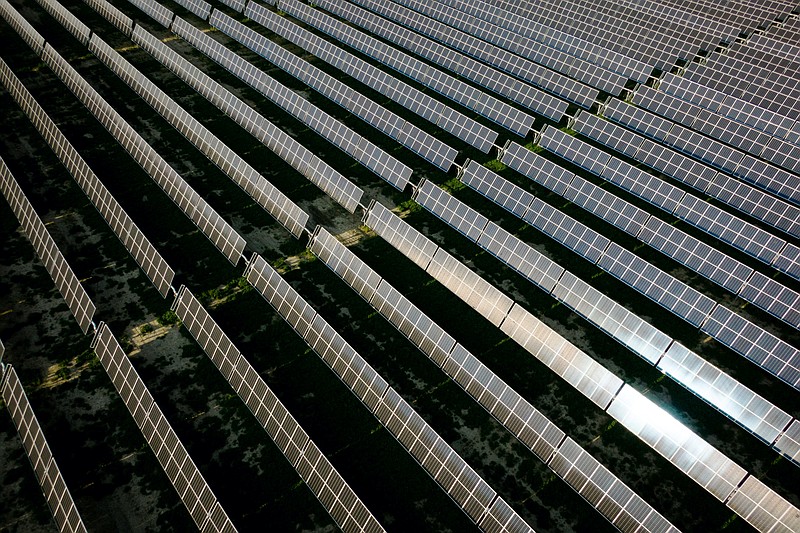The saga of the would-be Bellefonte Nuclear Plant continues - but not with the Nuclear Regulatory Commission on board.
Nearly 47 years after construction began on the Bellefonte plant in Northeast Alabama, TVA is giving up its construction permit for America's largest unfinished nuclear plant. As the headline proclaimed in Sunday's Chattanooga Times Free Press, the announced surrender of that nuclear construction permit marks the end of an era.
"TVA has asked to withdraw its request that would have extended the Bellefonte permits until October 2022," NRC spokesman Scott Burnell said earlier this month. "The staff is processing that request, and absent any additional developments, the permits will expire when this October begins."
So now what? TVA still owns the 1,600-acre site, as well as the plant that has never - and likely now will never - generate the first spark of nuclear-produced electricity. But that doesn't mean it can't make power some other way. A gas plant? Uggh. A wind field? Seems unlikely given the stillness of North Alabama. A solar plant? That could be more of a possibility. All of the transmission equipment and the electrical grid is at the ready. And we've been asking this question since 2016.
But don't get excited. We've been here before.
In 2006, TVA had canceled Bellefonte's construction permit after work on the original reactor was idled in 1988. Then the utility proceeded to gut the plant's two steam generators and other equipment for scrap before doing another about-face. The utility then decided to dust off the shuttered, damaged plant and ask the NRC to reinstate its license.
Anti-nuclear groups questioned the wisdom of NRC reinstating the license. Arnold Gundersen, a nuclear engineer and former executive at Nuclear Energy Services in Danbury, Conn., argued to the NRC that while and after TVA ripped out and sold vital parts of the plant for scrap, Bellefonte's reactor was not maintained in accordance with NRC regulations. Those records couldn't just be recreated, he noted.
TVA claimed "testing" found all was well, and the NRC reinstated the license.
But then TVA changed direction again. Fast forward to last month when a federal judge ruled that TVA could in fact cancel the sale of the plant to financier Franklin L. Haney and his newly formed company, Nuclear Development LLC.
By now - after siting, building, scrapping, building again, abandoning, putting up for sale, agreeing to sell for pennies on the dollar and finally going to court to defend not selling the Bellefonte Nuclear Plant - TVA ratepayers and taxpayers have lost somewhere between $6 billion (according to TVA) and $9 billion (according to a 2018 letter from five congressmen).
Bellefonte's final sale to Haney was contingent on him and his company jumping through enough hoops to gain the confidence of the NRC and/or TVA to ensure the transfer of that construction permit. When Haney could not make first one then another extended deadline for the transfer, TVA balked on the sale. Haney sued the utility and lost. He has until sometime in October to appeal.
So we ask again. Now what?
TVA spokesman Jim Hopson said Wednesday that TVA is making no decisions immediately.
"But we're not taking anything off the table," he added, noting that the utility is seeking "the opinions of those [leaders and people] in Jackson County on what they want us to do with the property - whether it's developing it ourselves or to see it returned to some kind of productive use by another company, and what that might look like."
Pressed on the question of a solar farm on Bellefonte's vast acres, Hopson said solar panels on that acreage would produce between 160 and 300 megawatts of electricity - about a fourth as much as Bellefonte would have generated as a nuclear plant had it ever produced even one spark. Likewise, he said, aside from a solar farm's construction, its maintenance would require considerably fewer workers than a nuclear plant. On the other hand, Bellefonte hasn't employed more than about 25 or 30 people for most of its nearly 50 years.
But - on the bright side - as he said, nothing is off the table.
In February 2020, TVA said it would be looking to the sun for more of its future power and would boost its solar energy capacity by 44% over that of 2019 by adding 484 megawatts of new contracted solar generation. That included a $200 million solar farm near Columbus, Mississippi, that would both generate and store electric power.
TVA also at that time began studying whether to buy 2,474 acres in Alabama near Muscle Shoals to build up to a 227-megawatt solar farm - the biggest solar generation project owned by TVA.
Hopson said TVA's May 2021 "strategic intent and guiding principles" notes the utility has solar commitments to date of more than 2,300 megawatts of solar capacity expected to come online by the end of 2023. Including those projects, TVA expects to add 10,000 megawatts of solar power by 2035 - a 24-fold increase from today.
That 10,000 megawatts of solar power would be equal to more than eight would-be Bellefonte reactors.
So, folks, we ask again: How about Bellefonte?
Be bold. Look to the sun.
